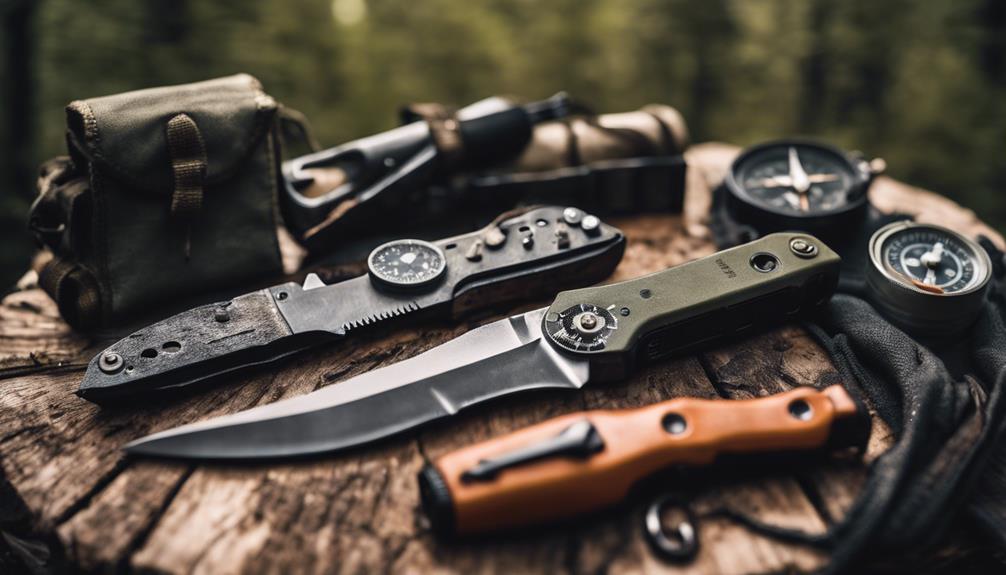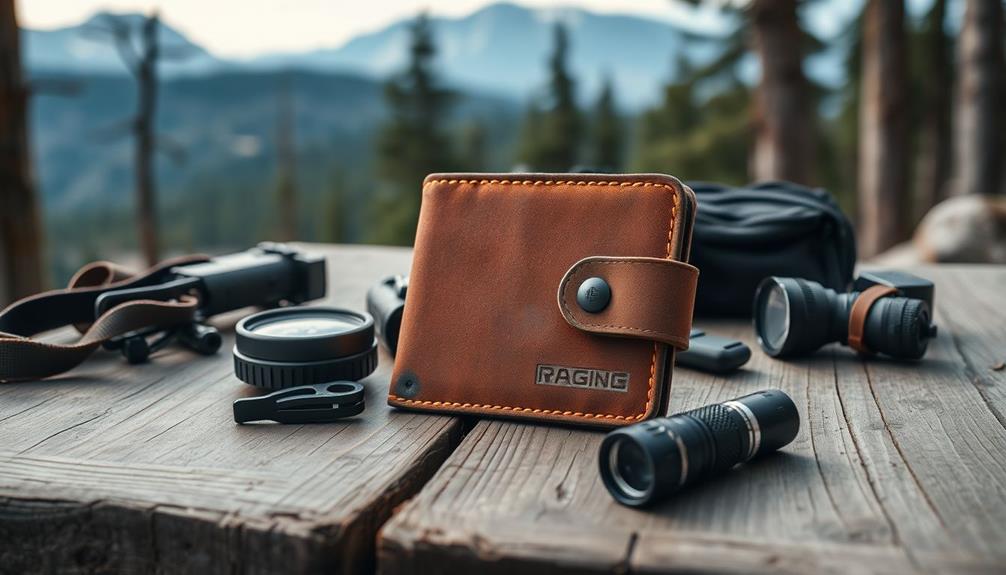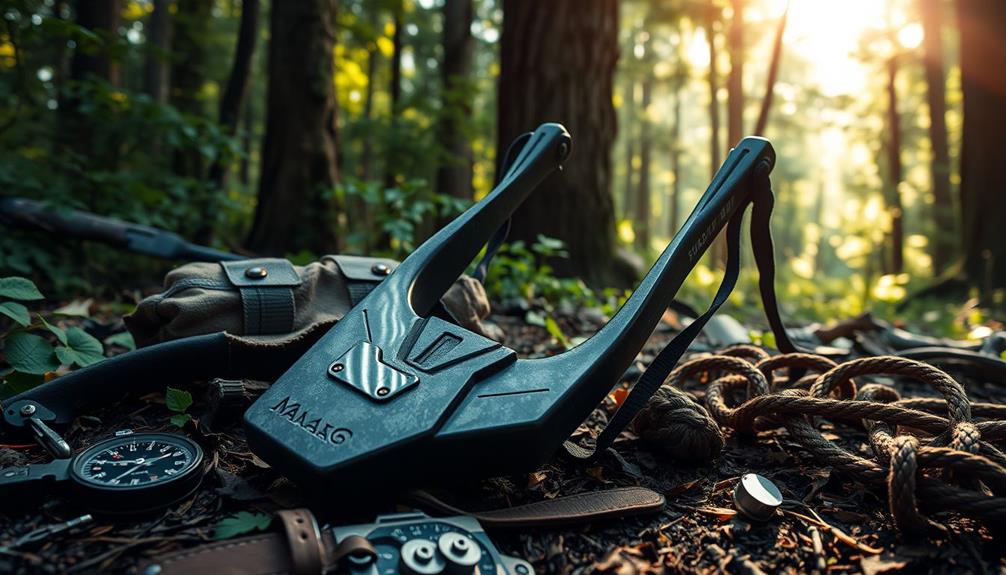Choosing your ultimate survival knife involves understanding your needs and the knife's capabilities. Versatile knives serve multiple functions, from cutting to self-defense. Consider blade material, typically high-carbon stainless steel, and an appropriate length between 4 to 10 inches for balance. A secure handle guarantees comfort during extended use. Historical options like the Bowie or Kukri offer unique benefits, while alternatives like machetes and multitools provide additional utility. Ultimately, your selection should reflect personal requirements and heritage, shaping your confidence in survival situations. Explore more about the significant nuances in knife selection to enhance your preparedness. For everyday carry, a perfect pocket knife should be compact, lightweight, and easily accessible. Look for a foldable design and a durable locking mechanism to ensure safety when not in use. It’s also important to consider the type of tasks you may encounter on a daily basis, such as opening packages or cutting materials, and choose a blade shape and size that fits those needs. Overall, finding the perfect pocket knife involves finding the right balance between convenience and functionality.
Key Takeaways
- Consider blade material; high-carbon stainless steel offers durability and resistance to corrosion for long-lasting use in survival situations.
- Select an appropriate blade length between 4 to 10 inches for versatility while ensuring comfortable handling during extended tasks.
- Choose a handle design that provides a secure grip, using materials like rubber or textured polymers for added safety and control.
- Assess the knife's weight; it should be well-balanced for easy carrying without compromising strength, enhancing usability during emergencies.
Importance of Survival Knives
Understanding the importance of survival knives lies in their critical roles as versatile tools in emergencies and minimalist kits, where functionality and reliability are paramount.
These blades serve multiple purposes, from cutting and chopping to self-defense, making them indispensable for outdoor enthusiasts and survivalists alike.
The diversity in styles, lengths, and weights allows users to select a knife tailored to their specific needs and preferences.
While functional survival knives can be acquired affordably, premium options can exceed $1,000, reflecting the craftsmanship and materials involved.
Furthermore, historical significance adds depth to the knife's utility, as many designs have evolved from essential tools for survival to modern iterations that continue to serve in various capacities, ensuring their enduring relevance.
Historical Context of Survival Blades
The historical context of survival blades reveals their evolution from practical tools used by ancient cultures to modern multifunctional designs, underscoring their significance in both everyday life and survival scenarios. Early survival knives, such as the seax and Kukri, were integral to various cultures, serving both utility and combat purposes. Over time, these blades have adapted to meet the diverse needs of users, combining traditional craftsmanship with modern materials and technologies.
| Historical Blade | Primary Use |
|---|---|
| Seax | Utility and Combat |
| Kukri | Utility and Combat |
| Bowie Knife | Utility and Combat |
| Modern Survival Knife | Multifunctional |
Exploring the Bowie Knife

Exploring the features and applications of the Bowie knife reveals its adaptability as both a practical tool and a combat weapon throughout history. This iconic blade, originally designed for versatility, now serves multiple purposes, making it a popular choice among outdoor enthusiasts and military personnel alike.
Key characteristics include:
- Robust Blade: Typically 5 to 12 inches long, providing ample cutting power.
- Clip Point Design: Enhances precision for intricate tasks and thrusting capabilities.
- Comfortable Grip: Designed for extended use, ensuring user control and safety.
- Durable Materials: Modern Bowie knives incorporate advanced steel and handle materials for longevity.
Such features not only underscore the knife's historical significance but also its relevance in contemporary survival scenarios.
Understanding the Kukri Knife
Known for its distinctive curved shape, the Kukri knife serves as both a versatile tool and a formidable weapon, deeply rooted in the cultural heritage of Nepal and the history of Gurkha soldiers. Its design allows for effective chopping, cutting, and stabbing, making it suitable for various tasks, from building shelters to butchering. The Kukri often includes a Chakmak for maintenance and fire-starting, while the Karda offers additional cutting capabilities. This knife's stout construction is ideal for woodcutting and survival scenarios.
| Feature | Description |
|---|---|
| Origin | Nepal |
| Blade Shape | Curved |
| Primary Uses | Chopping, cutting, stabbing |
| Additional Tools | Chakmak (maintenance), Karda (cutting) |
| Significance | Integral to Gurkha culture |
Selecting Your Ideal Knife

Finding the right knife for survival situations requires careful consideration of individual needs, preferences, and the specific tasks intended for the tool. To guarantee you select the ideal knife, consider the following factors:
Blade Material: Opt for high-carbon stainless steel for durability and corrosion resistance.
Blade Length: Choose a blade length that balances versatility with ease of handling, typically between 4 to 10 inches.
Handle Design: Verify the handle provides a secure grip, considering materials like rubber or textured polymers for comfort.
Weight: Select a weight that allows for easy carry without sacrificing strength, as a well-balanced knife enhances usability.
The Psychological Aspect of Knives
The psychological significance of knives extends beyond their practical utility, often intertwining with personal identity, cultural heritage, and emotional connections that influence an individual's choice in survival tools.
A knife can symbolize strength, resilience, and self-reliance, serving as a tangible reminder of one's capabilities in challenging situations.
The attachment to specific knife designs, such as the Bowie or Kukri, can reflect cultural backgrounds and personal stories, enhancing the connection to the tool.
Additionally, the familiarity and comfort that come with a chosen knife can instill confidence, essential for effective performance in survival scenarios.
Ultimately, the decision to select a knife is not merely functional; it embodies deeper psychological factors that resonate with individual values and experiences.
Alternatives to Traditional Knives

Exploring alternatives to traditional knives reveals a variety of effective tools that can serve similar purposes in survival situations, each with unique advantages and historical significance.
These alternatives may not only enhance versatility but also provide specialized functions that address specific needs during emergencies:
- Machete: Ideal for clearing brush and chopping wood, the machete excels in outdoor survival scenarios.
- Multitool: Combining various tools, multitools offer flexibility and compactness, making them suitable for diverse tasks.
- Hatchet: Useful for splitting wood and crafting, a hatchet can serve as both a tool and weapon.
- Survival Axe: Engineered for heavy-duty tasks, survival axes provide strength and durability in challenging conditions.
Choosing the right tool depends on personal needs, ensuring readiness for various survival challenges.
Frequently Asked Questions
What Are the Legal Restrictions on Carrying Survival Knives?
Legal restrictions on carrying survival knives vary greatly by jurisdiction, encompassing factors such as blade length, type, and intended use. It's crucial to consult local laws to guarantee compliance and avoid potential legal consequences.
How Should I Maintain My Survival Knife for Longevity?
Properly preserving your survival knife's performance involves regular cleaning, careful conditioning of the blade, and consistent sharpening. Additionally, safeguarding against rust and storing it securely guarantees sustained sharpness and longevity, maximizing its essential utility.
Can Survival Knives Be Used for Everyday Tasks?
Survival knives are versatile tools that can effectively handle everyday tasks such as food preparation, cutting, and minor repairs. Their robust design guarantees reliability, making them suitable for both emergency situations and daily use.
What Materials Are Best for Knife Blades?
The heart of a knife lies in its blade materials, where strength meets resilience. High-carbon steel offers durability and sharpness, while stainless steel provides corrosion resistance. Ultimately, the choice balances performance, maintenance, and personal preference for practical applications.
Are There Specific Survival Knife Brands Recommended for Beginners?
For beginners, recommended survival knife brands include Morakniv, ESEE, and Ka-Bar. These brands offer reliable, durable options at accessible price points, ensuring functionality and comfort for novices managing essential survival scenarios effectively.
Conclusion
In the intricate tapestry of outdoor survival, the choice of an ultimate knife transcends mere functionality, weaving together history, craftsmanship, and personal connection.
The Bowie and Kukri knives, each embodying unique legacies, offer diverse capabilities tailored to myriad challenges.
Ultimately, selecting the right survival knife is akin to choosing a steadfast companion, one that inspires confidence and resilience in the face of adversity.
Such a decision not only enhances preparedness but also honors the enduring spirit of adventure.










